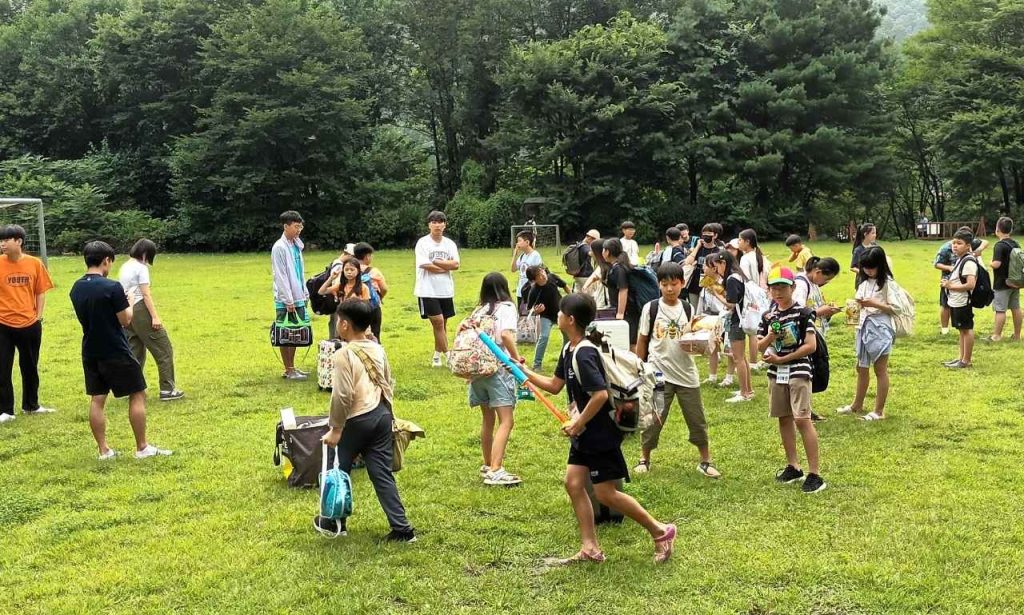Summer camp prices can shock parents these days. I witnessed this firsthand last year when my sister showed me what she paid for my niece’s art camp. Children get excited about these summer adventures, but our wallets take a serious hit. The current rates for day camps range from $200 to $800 weekly. Overnight camps cost even more at $1,500+ per week. With multiple children or several weeks of camp, expenses quickly reach vacation-level proportions. You can provide your children with an excellent summer experience without financial strain afterward. I’ve gathered effective strategies through years of helping clients and friends find affordable options. These aren’t low-quality alternatives, either—they offer genuine value and memorable experiences. Let’s explore how to plan for summer camp so you are not broke by fall.
Check Your Memberships

Most parents overlook substantial discount offers provided by their existing memberships. Current memberships in gyms, museums, warehouse clubs, and professional organizations present an opportunity to obtain significant savings.
During our lunch meeting last month, my friend Steve told me about his concerns regarding his daughter’s $350 science camp expense. I discovered that his wife’s children’s museum membership was a missed opportunity he had not thought of. The simple inquiry enabled them to cut their registration fees by 30%.
How to Maximize Membership Discounts
Take time to list every organization you belong to. Consider your YMCA, Costco, AAA, alumni association, and professional groups—even ones you rarely use. Contact each one specifically about summer program discounts.
Be persistent when inquiring about discounts. Sometimes, frontline customer service representatives aren’t aware of special offers. Request to speak with someone in youth programs for more detailed information. Many organizations offer unpublicized “member loyalty” discounts worth discovering.
The optimal time for these inquiries is January and February, when early registration discounts become available. My neighbor secured a YMCA camp at nearly half-price by registering in February using her family membership discount.
Combine Membership Benefits for Maximum Savings
The most effective approach combines multiple discount opportunities. Your credit union membership, early registration, plus sibling discount create substantial savings. My colleague Tracy reduced costs by nearly 40% for her children last summer.
Investigate reciprocal benefits from your existing memberships, too. A zoo pass might qualify for discounts at science centers nationwide through partnership agreements. My Botanical Garden membership unexpectedly gave my nephew a $75 discount on a nature camp in another state.
Check Out Scouting
Scout camps represent exceptional value in the summer camp market, yet many parents never consider them viable options.
How Scout Camps Keep Costs Down
The operational model for Scout camps differs significantly from commercial ventures. Scout camps typically own their facilities outright and utilize volunteer leadership. This translates to weekly rates between $150 and $350 instead of $500+ at comparable private camps.
These affordable options deliver quality experiences, too. Activities include swimming, hiking, building projects, and developing outdoor skills. My friend’s son returned from Cub Scout camp last summer enthusiastically describing archery lessons and building a functional catapult—experiences that cost twice as much at premium camps.
Joining Scouts for Camp Benefits
People who are not members do not need to sign up before taking advantage of these available opportunities. Summer activities serve as the main reason why families decide to become members. The affordable summer camp options become available to children after they sign up ahead of time and fulfill basic participation requirements.
One of my blog readers, Josh, successfully applied the approach he had learned from my blog. His daughter enrolled in the Girl Scouts in April and then attended their adventure camp in June. The expenses for membership, along with camp fees, totaled $295. The commercial adventure camp nearby charged $675 for an equivalent program.
See If There’s a Discount for Volunteering

The opportunity to save money through volunteering is the most substantial. Camps depend on adult volunteers regularly, providing generous compensation through free or discounted admission fees.
Types of Volunteer Positions Available
The majority of volunteer positions need only background check clearance to qualify. The combination of specialized expertise (nursing, lifeguarding, activity instruction) produces supplementary job prospects, while general counselor roles persist as regularly available positions.
I applied this method during the summer of 2018 when I provided marketing help to a nearby arts camp. After spending three hours on social media strategy development, my nephew obtained two weeks of free programming worth $800 without requiring a substantial time commitment.
How to Approach Volunteer Inquiries
The best period to search for volunteer positions occurs in January rather than waiting until late spring when all roles have already been assigned. Camp directors complete their staff recruitment decisions during the months leading up to the upcoming season.
Specific offers yield better results than general inquiries. A targeted message identifying your skills and availability demonstrates immediate value to camp administrators. Mentioning your child’s interest in attending establishes a clear mutual benefit in the arrangement.
Check with Local Houses of Worship
Religious institutions frequently offer remarkably affordable summer programs open to all families, regardless of religious affiliation.
Community Outreach Through Summer Programs
These organizations approach summer programming as community service rather than profit-generating ventures. They leverage donations, existing facilities, and congregation volunteers to minimize costs. This results in weekly rates of $75-$150 for programs that commercial operators would price at $300+.
While researching options for a client last year, I discovered an excellent example of this value proposition. A Presbyterian church near his home offered an eight-week day camp, including swimming, field trips, and diverse activities, for $90 weekly, with no requirement to attend their services. Equivalent commercial programs charged $275-350 weekly for virtually identical experiences.
Finding These Hidden Gems
These programs typically operate with limited marketing budgets, requiring more investigative effort. Direct phone calls prove most effective—contact houses of worship within reasonable driving distance and inquire about summer children’s programs.
Neighborhood social media groups provide another valuable resource. Parents often share information about affordable local options in community forums. My assistant discovered her son’s favorite program through a community group comment—a Buddhist temple offering meditation and martial arts instruction for $125 weekly, far below market rates for similar activities.
Consider Religious Camps
Religious camps offering specialized programs benefit families who accept religious elements in their programming.
Value-Based Programming
The camps provide additional programs through their regular summer activities that help develop participants’ character. Children experience identical camp activities, including swimming, sports, crafts, and outdoor activities, yet parents find new educational content beneficial.
Overnight religious camps provide better financial value to families by charging $400-600 weekly, whereas secular camps charge $800-1200. My sister sends her children to a Catholic summer camp in Michigan that provides five days of waterfront activities, horseback riding, and evening programs at a rate of $425. The YMCA overnight program costs $975 while giving identical services to religious camps.
Finding the Right Fit
The membership requirement to join a particular faith community does not exist. Participants from multiple backgrounds attend religious camps, yet these programs operate under different organizational schedules. Spiritual content at these camps appears in two ways: continuous daily sessions or limited to specific morning and evening time slots.
Direct conversations with camp directors clarify each camp’s expectations. Discussing religious history and comfort zone allows camp directors to confirm that their program philosophy aligns with your expectations.
Check Out Local Nonprofit Camp Options
Nonprofit organizations focus on making their services accessible rather than focusing on profit, which results in superior value propositions for their clients.
Organizations to Investigate
Several established nonprofit organizations consistently offer affordable options:
Boys & Girls Clubs provide structured day programs starting around $85 weekly, offering substantive activities such as sports, arts, and field trips.
4-H has expanded beyond its agricultural roots to include science, technology, leadership development, and creative arts at reasonable rates.
The Salvation Army, nature conservancies, and community foundations operate quality programs that many parents overlook.
During research conducted for my email subscribers last summer, I discovered a wildlife foundation offering a full-day nature camp, including canoeing and wildlife tracking, for $175 weekly. A commercial wilderness program nearby charged $525 for remarkably similar activities and curriculum.
Understanding the Nonprofit Advantage
These organizations access funding sources unavailable to commercial operators, including grants, tax-exempt donations, and volunteer support. Many also offer sliding fee scales or scholarships for families needing additional assistance.
A single-father friend working long hospital shifts needed affordable summer care for his twin sons. The local Boys & Girls Club provided reasonable weekly rates and extended hours compatible with his work schedule. Commercial alternatives charged $380 weekly plus additional fees for extended care, while the Club offered comprehensive programming for $95 inclusive.
Look for Community Playground Programs

Municipal recreation departments operate cost-effective summer programs that are frequently overlooked in favor of heavily marketed commercial options.
City and County Programs
City parks and recreation websites merit immediate investigation, as popular programs fill quickly. These municipal options typically cost $50-150 weekly while providing supervised activities, sports instruction, and often swimming lessons.
My cousin’s daughter participated in a city-sponsored theater camp last summer, which cost $125 for a full week and culminated in a public performance. A private performing arts program nearby charged $395 for essentially identical instruction and performance opportunities.
Making the Most of Municipal Options
Combining different municipal programs creates a customized, affordable summer schedule. Registering for soccer camp in June through city recreation, art classes in July through the community college, and nature exploration in August through county parks provides diverse experiences at substantial savings.
Residence within city limits typically qualifies families for reduced rates. Multiple-child enrollment and extended registration often trigger additional discounts. Directly asking about available rate reductions frequently reveals savings opportunities that are not prominently advertised.
Conclusion
Exceptional summer activities for your children will not result in long-term financial pressure during the fall season. The successful planning method diverges from standard parental behavior, focusing on choosing from well-advertised commercial choices.
Research should begin in January to achieve the best outcomes. Investigate membership deals, volunteer positions, religious institution activities, and municipal recreational programs. Always ask about available scholarships and multi-child discount opportunities.
The cost of an experience does not determine its quality level. Children appreciate swimming opportunities, the chance to make new friends, and active involvement in activities, ending their days contentedly exhausted. This can all be found through affordable alternatives if you search for them. Advanced preparation enables the creation of meaningful experiences for your children and establishes financial security for your domestic budget.
Also Read: 9 Best Income-Producing Assets to Buy
FAQs
January provides optimal timing for early registration discounts and maximum program availability.
Using these strategies, day camps cost $75-$200 weekly, and overnight camps cost $300- $500. Standard retail rates typically cost twice these amounts.
Yes. Organizations like Easter Seals offer specialized programs; many traditional camps provide inclusion support services.
Options include sliding-scale fees, payment plans, camperships, and traditional scholarships. Direct inquiries yield the best results.




